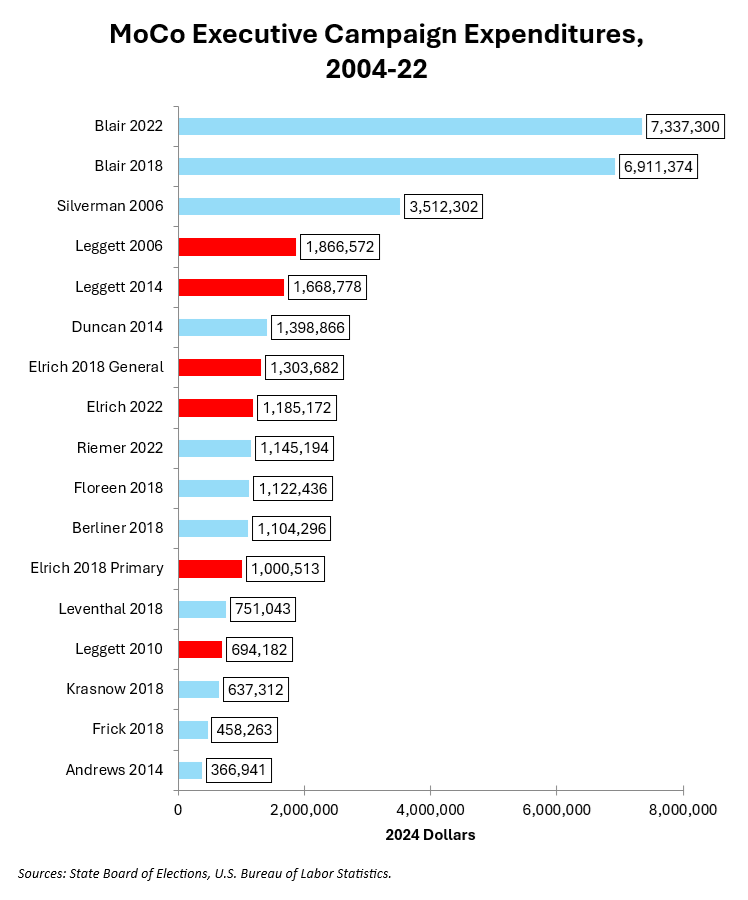By Adam Pagnucco.
The January 2025 campaign finance reports are in, the last before next year’s primary season goes into full swing. Let’s have a look, starting with the county government’s elected officials.
The table below shows stats for the cycle for the county executive and the eleven county council members. Begin balance is the cash balance at 1/12/23, the start date of the January 2024 report. Total raised, total spent and net raised combine the January 2024 and January 2025 reports. End balance is the cash balance at 1/8/25, the end date of the January 2025 report. Burn rate is the percentage of receipts that has already been spent.

I don’t normally brand data that I collect as non-meaningful, but I’ll do it this time – for the most part. For almost all of these candidates, this information says little or nothing about what they will ultimately have by the end of the cycle. Let’s review.
Marc Elrich – The county executive is term limited and cannot run for that office again without sitting out one term. He has announced that he will run for a county council at-large seat. He will almost certainly open a new public financing account for that race and will be, at minimum, financially competitive.
Sidney Katz – The District 3 council member is also term limited. He could run for a different office, but since he is 74 years old, he may choose to retire.
Dawn Luedtke – She has not raised a lot of money so far but that’s partly due to the nature of her Upcounty district, which lacks the well-heeled donors who roam freely in and near the Beltway. She looks to be on pace to defend her seat and may not have a serious challenger.
Other Candidates in Public Financing – Most county elected officials have participated in public financing in at least one of the last two cycles. The county distributes public matching funds, which form the bulk of money raised by candidates in public financing, starting 365 days from the primary, which will be held on June 30, 2026. So none of the candidates in public financing had an incentive to raise money by the 1/8/25 deadline of the new reports. Gabe Albornoz and Kristin Mink have not bothered to open public financing accounts yet.
All of the candidates listed as being in public financing were financially competitive last time and – after all – they were elected. The fact that they have no money now says nothing about what they will have a year from now, or sooner.
That leaves District 1 Council Member Andrew Friedson, the man my sources picked as the strongest contender to succeed Elrich as county executive. After a competitive open seat race in 2018, Friedson had no opponents in 2022 and has steadily accumulated a bulging war chest. On 1/8/25, he reported more than a million dollars on hand. How good is that?
To find out, I researched the spending of candidates for county executive since the 2006 cycle. I then used the Washington-Arlington-Alexandria CPI-U to adjust it for inflation into 2024 dollars. That data is shown in the chart below. Notes: County Executive Ike Leggett had no opponent in the 2010 primary. Elrich’s spending in 2018 is broken out into primary and general totals since he had a rare competitive general election that year. Winning campaigns are shown in red.

This data indicates that county executive candidates generally need at least a million dollars to win. Friedson already has that much money without formally announcing for executive and with a year and a half to go until the primary. One can only imagine how much more he can raise until then.
Hence the title of this column.
Now let’s offer three caveats.
First, when looking at past county executive elections, let’s remember that the best-financed candidates do not always win. If they did, the last two executives would have been named Steve Silverman and David Blair.
Second, as a district council member potentially facing at-large competitors like Council Members Evan Glass, Will Jawando and Gabe Albornoz, one could say that Friedson needs extra money to introduce himself to voters outside his home base. I think that’s a fair argument but it’s somewhat weakened by the Greater Greater Washington poll showing that none of these folks has a lot of name recognition.
Third, public financing offers a path to get to more than a million dollars in a county executive race. Elrich hit that mark on three different occasions and former Council Member Hans Riemer also got there in 2022. There is no reason to believe that Glass, Jawando, Albornoz or someone else could not perform just as well. But here’s the thing: public matching funds in an executive race are limited to $870,170 in a primary. When combined with the current limit of $500 on individual contributions, that should produce maximum campaign budgets not exceeding $1.5 million even for the best fundraisers (like Glass). Friedson will almost certainly have more money than that – probably a lot more.
So will King Andrew claim MoCo’s throne? That’s hard to say, particularly with Baron Glass, Duke Jawando, Earl Albornoz and Count Madaleno potentially gathering supporters in the countryside along with assorted commoners. Friedson is off to a good start, but there will be many twists and turns until the voters crown the next ruler of the second floor.
